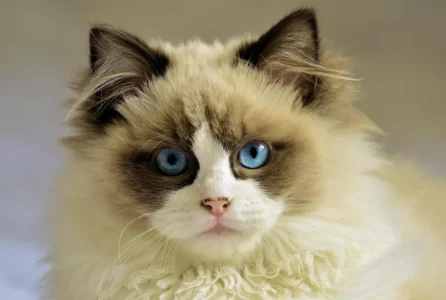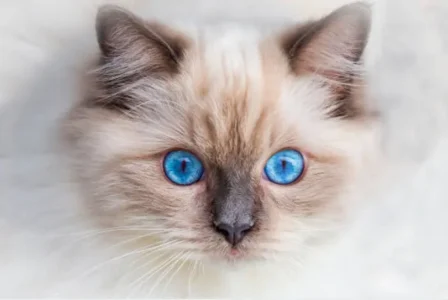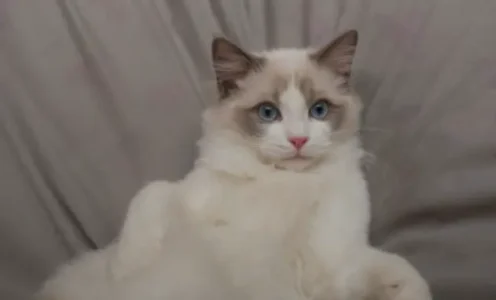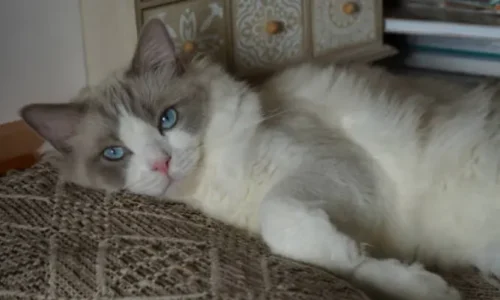Since blue is a favorite color for many people, the Blue Bicolor Ragdoll is also widely loved and has gained a lot of popularity because of it. What makes it unique are its cool greyish-blue color and unique white markings.
It is quite similar to the Seal Bicolor Ragdoll because in this breed too, the ears, tail, and some parts of the face appear blue-grey, and there is a white inverted “V” mark on the face which gives it a soft and classic look.
I am very impressed with the gorgeous blue eyes and silky, semi-long fur of the Blue Bicolor Ragdoll breed, and I am sure you will love it too.
In this article, I will tell you about many of its benefits.
Table of Contents
What is a Blue Bicolor Cat?
Blue Bicolor Cat, as its name suggests, is a mixture of two words, Blue and Bicolor, which have very different meanings.
Blue refers to the blue markings on the ears, tail, nose, and “saddle” on the back. Bicolor means that it is a mixture of two color patterns in which there is a predominance of white and a coat of blue here and there.

The Ragdoll cat breed has special white markings and an inverted-shaped mark on its face called a “V”.
Some key features of blue bicolor cat:
- Blue color (Grayish-Blue): The blue color is usually on the ears, tail, and eyes, which are actually diluted black
- Coat Patterns: Coat patterns are available in a wide variety such as the tuxedo pattern, van pattern, harlequin pattern, cap-and-saddle pattern, etc
- Eye Color: Eye color is usually bright blue which matches her face very well
- Coat: The coat color is usually a combination of blue (greyish-blue) and white, called a “bicolor” pattern
- Body: There are only two colors on its body, white color is usually on the chest, belly, side, and somewhat face, while the back and tail are soft blue.
Genetics of a Blue Bicolor Ragdoll
It is not a common thing for a blue bicolor Ragdoll to look so beautiful, its gene is behind it which is responsible for everything from the color of its eyes to the color of its body.
1. Colorpoint Gene (cs)
The colorpoint gene causes the blue bicolor Ragdoll’s body to have darker “point” colors.
This gene allows pigment to be present in cool areas of the body—such as the ears, paws, face, and tail—while warm areas, such as the stomach and back, are lighter in color.
This happens because this gene is a temperature-sensitive gene, which is active only in cold places.
2. Color Dilution Gene (d)
This is a recessive gene that makes the color of the fur of any cat light or faded, which looks very beautiful and attractive.
If a cat inherits the D gene from both parents (i.e. homozygous d/d) then significant changes in color occur, such as black turning blue (grey) and chocolate turning lilac.
3. White Spotting Gene (S)
This is a type of dominant gene (meaning if one parent has the “S” gene, then the chances of children having white spotting are quite high) which is responsible for white patches on the body.
This gene prevents melanin-producing cells from reaching certain parts of the body, causing white spots to appear there.
Key Characteristics of Blue Bicolor Cats
The character of any cat is very important because it determines its behavior, nature, and temperament, that is why its character has been discussed in detail below.

1. Stunning Coat Color and Pattern
The coat color of the Blue Bicolor Cat is bluish-grey (blue) in color which gives a very attractive, beautiful, and elegant look. It also has white patches which give its fur a unique bicolor pattern.
It has a white inverted “V” shape on its face, along with its chest, belly, and legs are white which creates a perfect contrast with its blue-grey ears, tail, and back.
2. Beautiful Eye Color
The most special thing about the Blue Bicolor Cat is its eyes, whose color is bright and vivid blue, it is very beautiful and charming due to which its overall look becomes even more beautiful and elegant.
These intense blue eyes give their face a charming and expressive look, which instantly grabs attention.
3. Unbelievable Facial Features
Viewed from the front, its face shows a white inverted “V” shape that extends onto its forehead.
Generally, her face is very soft and expressive which looks very cute and approachable but this inverted V shape makes her face even more unique and recognizable.
4. Size and Build
Size and Build refers to the Blue Bicolor cat’s external appearance and body structure, i.e. how strong and big it is.
Their body shape is quite balanced, so males weigh around 15-20 pounds and females are slightly smaller than males, around 10-15 pounds.
5. Grooming Needs
Grooming is one such factor that takes the beauty of the blue bicolor cat to the next level.
In this you can do many things like cleaning its fur, cutting nails, bathing it regularly, keeping it in a clean place and many more things.
Blue Bicolor Ragdoll Color Progression
Color progression is a unique feature in Ragdolls that distinguishes them from normal cats. They are born completely white, and slowly, over time, they change their color and pattern.

You will be surprised to see this progression and forced to wonder why all this is happening.
With the help of this chart, I try to make it very easy for you to understand:
| Age | Color Description | Notes |
| Newborn (0–1 week) | Almost pure white all over. No visible color on points | Born completely white due to inactive colorpoint gene |
| 2–3 weeks | Light grey-blue starts appearing on ears, nose, and tail tip | First signs of blue color on cooler parts (ears, nose, tail) |
| 4–6 weeks | The ears and tail show a more defined blue-grey color. A facial “V” mask begins to appear | The appearance of an inverted white “V” on the face |
| 2–3 months | Steel blue starts developing on ears, mask, and tail. His body was still pale | A clear bicolor pattern visible on the white chest, legs, and belly eyes begin turning blue |
| 4–6 months | Points deepen in color. The body gets a cool cream or bluish-white tone | Blue-grey points darken the body fur and start showing contrast |
| 7–12 months | Coat gets richer. Points and body color are now clearly visible | True bicolor contrast is when well-developed eyes turn vivid blue |
| 1–2 years | The final adult color appears. The coat is fluffy, with deep blue points and a soft bluish body | Full adult coat steel blue points body bluish-beige |
| 2+ years | Slight deepening of point color may occur with age. The pattern remains stable | Color may darken with age or cold weather patterns may stay unchanged |
Personality and Temperament
Personality:- The meaning of personality is quite simple and effective as can be known about many of his activities like how many claims he makes, how friendly and benevolent he maintains with others, how he reacts and many other things revealed about his personality.
If we talk in simple language, then it can be seen in any cat’s personality whether he is more playful or lazy, friendly with people or shy, and most importantly, he is curious, bold, or behaves independently.

Temperament:- Temperament is a serious topic and it is very important to understand it because it is related to the genes of the cat and starts as soon as the cat is born.
Temperament is a natural trait of the cat, which means it can be seen as soon as the cat is born, such as how calm it is, how active it is, or how shy it is. It depends on their breed, genes, and a little bit on the environment, but mostly it happens inborn.
Common cat temperaments that you need to understand:
- Affectionate:– Loves cuddles, enjoys being around people, and seeks attention.
- Independent:– Likes spending time alone and doesn’t always need human interaction.
- Playful:– Energetic and loves playing with toys, chasing things, and exploring.
- Shy or Timid:– Gets scared easily, hides from strangers, and avoids loud noises.
- Calm or Laid-back:– Very relaxed, quiet, and not easily bothered or excited.
- Vocal or Talkative:– Meows often to express itself and “talks” to its owner.
- Curious:– Always exploring new things, loves to watch and investigate surroundings.
- Aggressive:– May hiss, growl, or bite if annoyed or scared — usually needs space.
- Loyal:– Forms deep bonds with certain people and follows them around.
Care and Grooming Tips
Blue Bicolor Ragdoll cat has a lot of features that make them look very beautiful but to maintain all these things, it is very important to take care of them and do grooming.
Care and grooming account for about 40 to 50% of the beauty of the Blue Bicolor Ragdoll so it is very important.
Here are some Care tips:
- Brush the Coat 2–3 Times a Week – Their soft, medium-long fur needs regular brushing to prevent tangles and reduce shedding
- Trim Their Nails Every 2–4 Weeks – Ragdolls are gentle, but regular trimming keeps them healthy and safe
- Clean Eyes Gently – Ragdolls may have watery eyes; use a damp cloth to clean gently if needed
- Play and Exercise Daily – Use feather toys, string, or puzzles to keep them active and prevent laziness
- Regular Vet Checkups – Ragdolls are generally healthy, but annual vet visits help catch any issues early
- Watch Their Weight – Ragdolls can gain weight easily, so control portions and don’t overfeed treats
Here are some Grooming tips:
- Use a Steel Comb for Undercoat – To help remove loose hair and avoid matting, especially around the neck and belly
- Check for Mats Behind Ears & Legs – These spots tangle easily. Gently detangle if needed
- Wipe the Face Regularly – Especially around the white fur areas to keep them clean and bright
- Bathe Occasionally (Optional) – Ragdolls usually don’t need frequent baths, but a gentle bath every few months can help
- Use Cat-Friendly Shampoo Only – Always use a mild, tear-free shampoo made for cats
- Keep Ears Clean – Check weekly. Use a cotton pad with vet-approved ear cleaner if dirty
FAQs
Q. Are Blue Bicolor Ragdolls rare?
Ans. Blue Bicolor Ragdolls are not very rare but are less common and highly desired for their unique blue-gray color and distinct white markings.
Q. Can Blue Mitted Ragdoll have a Pink Nose?
Ans. No, a true Blue Mitted Ragdoll does not have a pink nose—it typically has a gray (blue-gray) nose, and a pink nose may indicate a bicolor pattern or a mismarked mitted.
Q. Are Blue Bicolor Ragdolls good for families?
Ans. Yes, Blue Bicolor Ragdolls are excellent for families because they are gentle, affectionate, and get along well with children and other pets.
Q. Can I keep them outdoors?
Ans. It’s best to keep Blue Bicolor Ragdolls indoors because their trusting and gentle nature makes them vulnerable outside; supervised outdoor time or a secure enclosure is safer.
Conclusion
The blue bicolor ragdoll is a truly special and charming cat known for its striking looks, gentle personality, and affectionate nature. Their beautiful bluish-gray markings, plush coats, and captivating blue eyes make them visually stunning and loyal, loving companions.
It is not a miracle that this cat has all these qualities, but all these are the result of its genes which it got from its parents and grandparents.
I hope you like this blog of mine. If you have any questions, please comment below.

1 thought on “The Amazing Blue Bicolor Ragdoll”